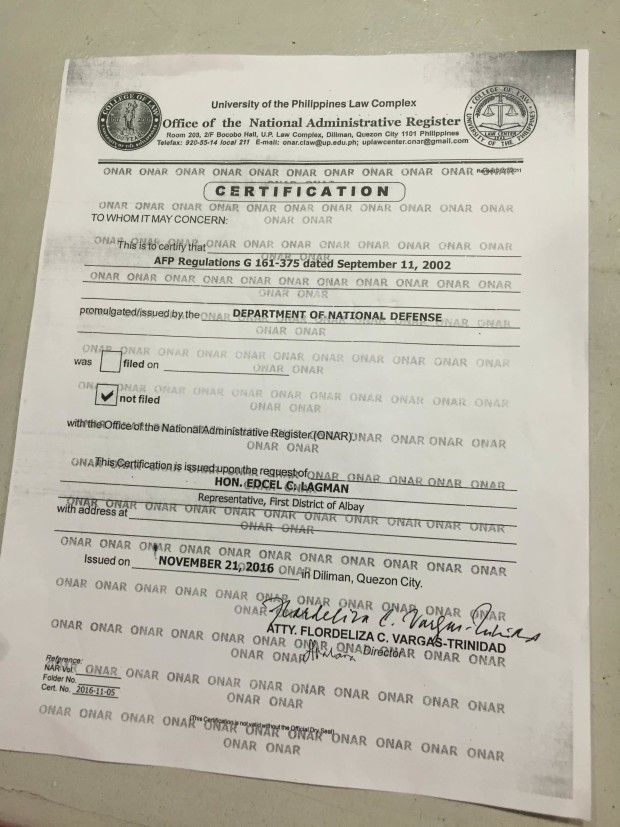
Certification from the Office of the National Registrar shows that the AFP regulation allowing Marcos’ hero’s burial was not registered, and therefore not in effect. Photo by Marc Jayson Cayabyab
The Armed Forces of the Philippines (AFP) regulation allowing the dictator Ferdinand Marcos to be interred at the Libingan ng mga Bayani was not in effect because it was not registered.
This was the claim of Albay Rep. Edcel Lagman, the petitioner in the Marcos’ burial, in a press conference at the House of Representatives on Tuesday.
Lagman said he was curious if the AFP Regulations G 161-1375 was not registered in the first place with the Office of the National Administrative Registrar (ONAR) at the University of the Philippines Law Complex.
It turns out the AFP regulation dated Sept. 11, 2002, that allowed Marcos to be buried at the military-run hero’s cemetery as a former president and soldier, was not even legally effective because it was not registered, Lagman said.
Lagman held up a certification which said that the AFP regulation was not filed with the ONAR. The certification was signed by Atty. Flordeliza Vargas-Trinidad and issued upon Lagman’s request.
The non-registration of the law also violates the Administrative Code of 1987, which requires every agency to file with the UP Law Center three certified copies of every rule it adopts, Lagman said.
The Code also states that each rule can only be effective upon 15 days from the date of filing.
Lagman said that prevailing jurisprudence has ruled that non-registration would rule out the efficacy of any rule, and therefore, there exists no AFP regulation that qualifies Marcos to be interred at the Libingan ng mga Bayani.
“If this was not filed provided under the Administrative Code, then it has no effect, it cannot be used as a rule or issuance to justify the entitlement of Marcos to be interred in the Libingan ng mga Bayani,” Lagman said.
“The prevailing jurisprudence is if you don’t register, the rule has no efficacy,” he added.
In voting 9-5 allowing a hero’s burial to Marcos, the Supreme Court said there is no law prohibiting Marcos’ burial at the hero’s cemetery, and that Marcos was qualified to have a hero’s burial according to the said AFP regulation.
READ: SC: ‘No grave abuse of discretion’ by Duterte on Marcos burial
The regulations state that among those qualified to be interred at the Libingan ng mga Bayani are Medal of Valor awardees, presidents or commanders-in-chief, ministers or secretaries of national defense, general/flag officers of the AFP, government dignitaries, statesmen, national artists, and others upon approval by the president or the Batasan Pambansa, among others.
READ: SC: Neither Cory nor Noynoy Aquino banned Marcos burial at LNMB
Meanwhile, those not allowed were those who were dishonorably separated, reverted, or discharged from the service and otherwise qualified personnel who had been convicted by final judgment of an offense involving moral turpitude.
But the Supreme Court said Marcos was not convicted by final judgment of the offense involving moral turpitude nor dishonorably separated/reverted/discharged from active military service.
The high court said the fall of the Marcos dictatorship due to a People Power uprising was not tantamount to Marcos’ dishonorable separation, reversion or discharge from the military service.
Marcos’ remains were sneaked in the Libingan ng mga Bayani on Friday for the secret burial, amid mounting protests. IDL/rga
READ: Marcos laid to rest in ‘sneaky’ rites at Libingan ng mga Bayani | Millennials lead protests vs Marcos burial